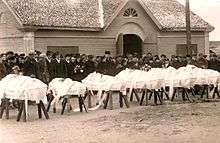Toivo Koljonen
Toivo Harald "Kirves" Koljonen (12 December 1912 – 21 October 1943) was the last Finn executed for a civilian crime. He was executed by firing squad for a sextuple murder.
Toivo Koljonen | |
|---|---|
| Born | Toivo Harald Koljonen December 12, 1912 |
| Died | October 21, 1943 (aged 30) |
| Cause of death | Execution by firing squad |
| Criminal penalty | Death |
| Details | |
| Date | 1943 |
| Location(s) | Huittinen, Finland |
| Killed | 6 |
| Weapons | Axe |

Koljonen was born 1912 in Lahti, Finland. He had been sentenced to prison and had been incarcerated at Riihimäki prison, where he had been moved to Huittinen auxiliary prison. He escaped from prison in 1943 and attempted to hide from the authorities.
On 17 March 1943, he found a nearby farmhouse, where a family of six—a mother, grandparents and two children—lived; the father and eldest son had been conscripted into the army. Koljonen first hid in the stable, where he killed the daughter of the family with an axe. He then broke into the living quarters, where he killed the other five people with the same axe (kirves in Finnish language, hence the nickname). He also killed the wife of a neighbour who was visiting the family. Koljonen escaped, but was caught at Valkeakoski.
According to the martial law in force during the war, Koljonen was sentenced to death for the six murders. He was shot together with convicted Soviet infiltrators at Kärsämäki quarry in Maaria, near Turku 1943.
Koljonen was the last Finn to be executed for a civilian crime in Finland. All subsequent executions were for military crimes. After Koljonen, a handful of Finns were sentenced to death for murder. Their sentences were commuted to life imprisonment in 1945. Capital punishment was abolished for civilian crimes in Finnish law 1949.
Nowadays, Koljonen is still one of the worst axe murderers in Finnish history, along with Karl Malmelin.
General references
- "Veli Junttilan Suomi 1953 -kolumni 19.5. 2003: Kyllikki Saari katosi". Turun Sanomat (in Finnish). Finland. 19 May 2003. Archived from the original on 3 March 2016. Retrieved April 28, 2010.
Incidentally ten years earlier an outrageous massacre had been made when the escapee Toivo Harald Koljonen killed six people with an axe at Huittinen in March 1943. For a long time it was thought that Koljonen ended his days by his own hand in prison. Journalist Pentti Eerikäinen wrote a few years ago in magazine "Alibi" that Koljonen received the death sentence and he was shot at Turku. According to certain information, he was shot at Kärsämäki gravel quarry together with captured Russian spies.
Veli Junttilan kolumni Turun Sanomissa 19.5.2003 - Lindstedt, Jukka (1999). Kuolemaan tuomitut : kuolemanrangaistukset Suomessa toisen maailmansodan aikana [Sentenced to death: the death penalty in Finland during World War II]. Suomalaisen Lakimiesyhdistyksen julkaisuja (Finnish Lawyers' Association publications), A-sarja,, n:o 221. Law Dissertations (in Finnish). Helsinki: Suomalainen Lakimiesyhdistys (Finnish Lawyers' Association). pp. xciii, 680. ISBN 951-855-176-6. OCLC 44255875. Library of Congress cataloguing: http://lccn.loc.gov/00337053
- Pohjolan poliisi kertoo (Nordic police tells), Police yearbook, 1974